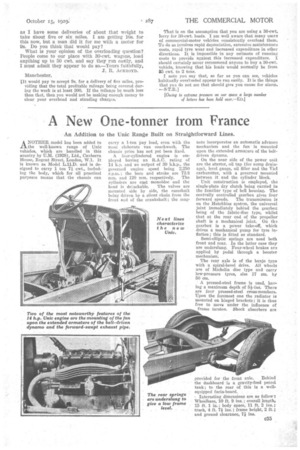A New One-tonner from France
Page 73

If you've noticed an error in this article please click here to report it so we can fix it.
An Addition to the Unic Range Built on Straightforward Lines.
liA NOTHER-model has been added to the well-known range of Unie vehicles, which are handled in this eountry by U.M. (1928), Ltd., Canberra House, Regent Street, London, W.1. It is known as Model L.11.D. and is designed to carry 1 ton 7i cwt., including the body, which for all practical purposes means that the chassis can carry a 1-ton Pay load, even with the most elaborate van coachwork. The chassis price has not yet been fixed.
A four-cylindered engine is employed having an R.A.C. rating of 14 lk.p. and an output of 80 b.h.p., the governed engine speed being 2,250 rum.; the bore and stroke are 72.8 mm. and 120 mm. respectively. The cylinders are mat monohloc and the
head is detachable. The valve,s are mounted side by side, the camshaft being driven by a silent chain from the front end of the crankshaft; the mag
neto incorporates an automatic advance mechanism and the fan is mounted upon the extended armature of the beltdriven dynamo.
On the near side of the power unit are the starter, oil tap (for sump drainage), level gauge, oil filler and the Viel carburetter, with a governor mounted between it and the cylinder block. Unit construction is employed, the single-plate dry clutch being carried in the familiar type of bell housing. The centrally controlled gearbox gives four forward speeds. The transmission is on the Hotchkiss system, the universal joint immediately behind the gearbox being of the fabric-disc type, whilst that at the rear end of the propeller shaft is a mechanical joint. On th3 gearbox is a power take-off, which drives a mechanical pump for tyre iiifiction; this is fitted as standard.
Semi-elliptic springs are used both front and rear. In the latter case they are underslung. Four-wheel brakes are applied by pedal through a booster mechanism.
The rear axle is of the banjo type with a spiral-bevel drive. All wheels are of Michelin disc type and carry low-pressure tyres, size 17 cm. by 50 cm.
• A pressed-steel frame is used, having a maximum depth of 516ns. There are four pressed-steel cross-members. Upon the foremost one the radiator is mounted on hinged brackets; it is thus free to move under the influence ef frame torsion. Shock absorbers are provided for the front axle. Behind
the dashboard is a gravity-feed petrol tank ; to the rear, of this is a wellequipped facia-hoard.
Interesting dimensions are as follow: Wheelbase, 10 ft. 9 ins.; overall length, 15 ft. 1 in.; body space, 11 ft. 2 ins. ; track, 4 ft. 7-i ins.; frame height, 2 ft.; and ground clearance, 7i ins.




























































































































